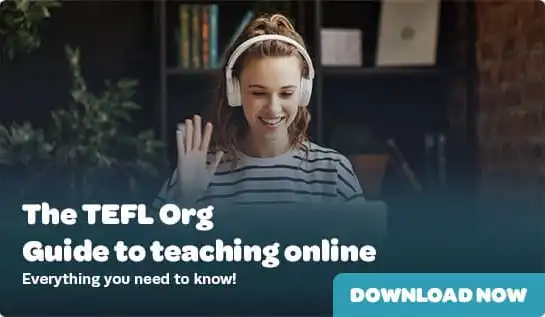- TEFL Courses TEFL Courses
- View all TEFL courses
- 120-hour Premier Online TEFL Course
- 200-hour Level-5 Online TEFL Course
- Online TEFL Courses
- Classroom TEFL Courses
- Combined TEFL Courses
- Virtual TEFL Courses
- TEFL Course Bundles NEW
- Advanced TEFL Courses
- TEFL Lesson Plans & Resources
- TEFL Gift Vouchers
- Which TEFL course is right for you?

- New to TEFL New to TEFL
- Locations
- TEFL Jobs
- Teach Abroad Teach Abroad
- Teach English Abroad
- Teach English in Japan
- Teach English in South Korea
- Teach English in Spain
- Teach English in China
- TEFL Salaries Abroad
- Requirements for teaching abroad
- Teach English abroad without a degree
- How to find teaching jobs abroad without experience
- Can you teach English abroad as a non-native speaker?

- Teach Online
- About Us
- Blog
- Podcast
Teaching English to refugees: tips & resources
Find out how you can help refugees at home or around the world as an EFL teacher.


TEFL course provider
TEFL certificate
teachers trained
find work within 2 months
If you’re looking to get into teaching English as a foreign language, there are a number of rewarding experiences ahead of you. Yes, there’s a lot to be said for starting your own online teaching business, moving abroad, or becoming a digital nomad: but what about making a sizeable difference on a more local level?
We’re all familiar with the spate of refugee crises over recent years. Wars and political upheaval in countries like Syria, Yemen, Ukraine, Palestine, and other regions, have displaced hundreds of thousands of people. Sadly, the sight of scared people fleeing war-torn locales is a regular sight on the news, wherever you live.
Seeing that, you might wonder: what can I do to help? Well, if you’re TEFL qualified, the answer is straightforward. It’s bad enough having to uproot and find shelter in a foreign country, but not knowing the language? That’s yet another barrier that a great many refugees have to face.
Your input could be instrumental in helping someone find their new life that bit easier; whether it’s getting into a local school, applying for jobs, or navigating the asylum process. So, how does a TEFL teacher get involved, and what’s needed?
Getting TEFL certified to teach refugees
The first thing you’ll need in order to teach English to refugees is a TEFL certificate. The industry standard is 120 hours, and whether you’re volunteering or you’re in full-time work, the standard remains the same.
It doesn’t matter that refugees and asylum seekers won’t have the same resources to pay an English teacher. For the purposes of this, you should be willing to give the best in TEFL teaching, and to do that, having a qualification is absolutely vital.
Having at least a 120 hour TEFL certificate means you can teach to the standard required by a school or online TEFL business. It might also be prudent to take an Advanced TEFL course in Exam Preparation. Exams like the IELTS and TOEFL are hugely important for non-native English speakers coming to English-speaking countries, as they can demonstrate an understanding of English for jobs, visa processes and more.
So, getting TEFL certified won’t just put you at a major advantage in the workplace, it’ll help your students to a massive extent. Yes, anyone with fluency in English can potentially teach it, but having the theoretical underpinning and structure to your lessons will provide a significant boost.

Types of teaching work with refugees
So, when we talk about the types of work you might be doing to help refugees, what exactly do we mean?
Find out how to make yourself useful and get into the right positions with our advice!
Volunteering
Volunteering is, obviously, a huge help. Your local community will have resources available for helping refugees and asylum seekers during the transition into life in an English-speaking country. Every major city has dedicated organisations, while some local councils ought to also have community centres where you can help out with English lessons.
Consult your local libraries and community centres - chances are, these will be the first ports of call for people who are new to the area and need guidance.
College ESOL courses
In terms of paid work, college ESOL (English for speakers of other languages) courses are a great route. Generally, once refugees and asylum seekers have managed to confirm residence, they’ll be signposted towards ESOL resources at local colleges.
This is a paid teaching gig, of course, and the demand for these kinds of roles is normally high. College term-times tend to be August to May, so in terms of recruitment, you’re best-placed to look for opportunities during the summer months. In terms of requirements, colleges will typically require teachers to have both a TEFL qualification and some level of experience, so if you've previously taught abroad or have been working on a voluntary basis you'll be in a better position for securing a paid teaching role.
A lot depends on resources and demand, but you can normally rely on colleges needing ESOL teachers on a regular basis.Teaching refugees online
In more recent years, the online sphere has opened up for refugees who want to learn English. Internet access has broadened, and through libraries, community centres and the like, nobody is too far from having access to the internet for at least a couple of hours per week.
With that in mind, a lot of great initiatives have emerged. Take, for example the Oxford International Education Group’s free English courses, which include language lessons on “Life in the UK, daily tasks and services, traditions and meanings, cultural awareness, media analysis and discussion, and debate”.
In the USA, there are online classes through the Immigrant Learning Center, focused on “speaking, reading, writing, listening, grammar, computer skills, and college and career preparation”. The point is, the opportunities for refugees in English speaking countries are available - and these initiatives need teachers.
Alternatively, you could provide lessons yourself. Through traditional advertising - notices in churches, shops, libraries etc - you can build an audience of people to teach English online.
Resources for teaching refugees
So, what resources will you need for teaching refugees? Well, first off, you’ll need the same resources as you’d use for teaching English in any scenario. Our exhaustive list of TEFL resources is a great place to start, and we’ll break it down into categories.
For lesson plans, we’d be remiss not to recommend some of the TEFL Org’s best stuff, but there are also packs available from Busy Teacher, ESL Library, One Stop English and TEFLtastic, including worksheets, guides for teachers and learning outcomes.
Apps are very useful for teachers and students alike. The likes of Duolingo always help, but if you’re wanting something more focused around the classroom, try Kahoot, Evernote, Vocab Victor or any of the others listed on our TEFL resources page. A virtual classroom, like Google Classroom or LearnCube, is advantageous, although depending on the size of your classes (it may just be one-to-one study), the likes of Zoom, Microsoft Teams or Skype will do the trick by themselves.For grammar lessons, check out the British Council, Grammar Monster or EF for a solid grounding in the material you’ll need to help your students. Video resources are also super helpful - our friend Claire Mitchell volunteers teaching English to refugees, and her lessons are available on YouTube. Speaking of YouTube, you’ll find myriad great teaching resources for teaching refugees; don’t be afraid to use clips from pop culture!
Refugee organisations worldwide
So, which organisations are available to prospective English teachers who want to help out refugees? Luckily, there are countless examples, too many to list on one page, so we’ve highlighted some of our favourites from the UK, the US, Ireland, Canada and Australia.
Organisations working with refugees in the UK
Red Cross have some excellent resources for teachers, and that’s no surprise - the organisation helps around 30,000 people going through the asylum process each year. Meanwhile, The Joint Council for the Welfare of Immigrants, Groundwork and the Unity Project regularly advertise for volunteers providing translation or English teaching services.
Refugee Action have a robust volunteering network, and Safe Passage are hiring volunteer interpreters and translators, as are Refugee Council.
Organisations working with refugees in the US
Refugee Council USA are constantly advertising opportunities for refugee assistance from coast to coast. ORAM (Organization for Refuge, Asylum and Migration) are a fantastic organisation which focuses on members of the LGBTQ+ community who have fled persecution, while Alight is an organisation based in the US that helps refugees in different parts of the world, with a robust educational volunteering programme.
World Relief Western Washington delivers English classes to refugees, from Family Literacy to classes for children or adults specifically. Hope English School has a similar function, as does the Refugee Educator Academy.
Organisations working with refugees in Ireland
Across Ireland, there are some excellent organisations offering free support and English lessons to refugees. Take, for example, Spirasi - based in Dublin, they offer 4 levels of English lessons, and are funded by the City of Dublin Education and Training Board (CDETB).In Cork, the Welcome English Language Centre welcomes 200 students a day, while Fàilte Isteach have volunteering opportunities across Ireland - you can even set up your own centre!
In Northern Ireland, Refuge Language offer free language lessons to refugees and asylum seekers, while SaorEd - launched in 2022 - is an online tool which connects those needing English lessons to the resources and teachers they need.
Organisations working with refugees in Canada
For a country the size of Canada, it’s hardly surprising that there are a number of great refugee volunteering platforms. The first and, potentially most well-known, is Immigrant Education, based in Calgary. Just fill out a volunteering form, tell them about your TEFL skills, and they’ll surely get in touch!
For opportunities across Canada, Volunteer Success is a portal which lets you see which roles are closest to you - both geographically and in terms of your skill set. Finally, Hi-Canada are always on the lookout for translators and people who can assist with English skills
Organisations working with refugees in Australia
If you’re based in Australia, there’s plenty for the prospective TEFL volunteer to get involved in. ASRC - the Asylum Seeker Resource Center, are looking for people to help with “Home English Teaching which provides one-to-one English support for people seeking asylum, usually in their homes or sometimes in a library, for an hour each week”.
On a similar note, Navitas Skilled Futures need volunteers with TESOL skills to help out, as do TAFE - both in South Australia through TAFE SA and in New South Wales via the TAFE NSW Volunteer Tutor Program.
The Smith Family Home Tutor Scheme is a programme which encourages one-to-one English learning in the home environment, and is based around “Northern Sydney, Illawarra, Hunter and Rural and Regional NSW”.
Interested in getting TEFL qualified to help refugees in your country? Take our quick course quiz to find out what course would be most suitable for you. And check out our previous blog post for more information about TEFL and volunteering.











